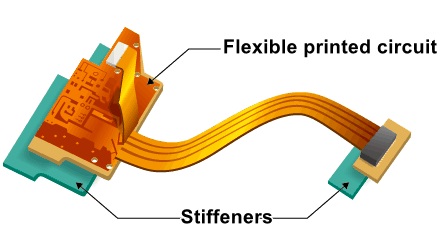The stiffener can be added to flexible circuits using adhesives, PP, or PSA. Stiffener flex PCBs are a common and important requirement in flexible circuits and rigid flexible boards, as they can be bonded to one or both sides of the flexible zone. The reinforcement is not an electronic component, but a mechanical support or heat dissipation component, which has a significant impact on the performance and reliability of flexible printed circuits. However, not all flexible circuits need to be strengthened.

Flex PCB stiffener material
Usually, the stiffener flex PCB in flexible PCB manufacturing is composed of polyimide, FR-4, aluminum, and stainless steel. Choosing the appropriate stiffening material is important because different stiffening materials have their benefits in different applications.
Polyimide: Polyimide (PI) stiffener materials are most commonly used under the FPC gold finger and are inserted into ZIF connectors. The connector specifications stipulate that the flexible circuit at the exposed ZIF contact finger must have a specific thickness to engage the connector. The two most common ZIF finger thicknesses are 0.3mm and 0.2mm. Of course, these thicknesses have tolerances, such as 0.03 millimeters or 0.05 millimeters.
FR-4 stiffeners: FR-4 stiffeners are used to provide support for flexible design areas with components and/or connections. Stiffeners prevent flexible circuits from bending at or near components or connectors. If FR-4 stiffener is not added, it is likely to cause solder joint breakage or damage when bending the circuit board. When the holes on the flexible circuit and FR4 stiffeners are in the same position and diameter, to prevent misalignment of the manual bonding holes, it is necessary to expand the stiffener holes (access holes) by 0.15mm on each side. The bonding process of FR-4 stiffener requires drilling, registration, and pre-bonding of adhesives or prepregs.
Aluminum and stainless steel stiffener: Aluminum and stainless steel are two main types of metal stiffener, but they require customization and are costly. Therefore, compared to polyimide and FR-4 stiffeners, metal stiffeners have a higher cost and longer turnover time. Aluminum is usually used for heat dissipation, and stainless steel is usually used when the space of stiffener is very limited. However, the design requires more component area support than an equivalent thickness FR4 stiffener. The bonding process of aluminum stiffener requires drilling, milling, and pre-stacking of pre-impregnated materials. The bonding process of stainless steel stiffener requires drilling, laser cutting, registration, and pre-stacking of prepregs.
Why do we use stiffener on Flex PCBs?
As we have already determined, PCB stiffeners are needed to harden the required parts of the flexible circuit. Stiffeners are not part of PCB electrical requirements; They only provide mechanical functionality for flexible areas, which means that when using solder joints to connect components to the board, they can keep the circuit board upright.
When the weight of components and connectors placed in the flexible area begins to bend the thin flexible material of the circuit board.
When SMP pad components need to have a flat and rigid surface on the PCB.
When connectors that need to be inserted multiple times require stiffener to reduce the stress on the solder pads.
When it is necessary to maintain appropriate thickness in flexible circuits.
When it is necessary to reduce the stress on the flexible part during multiple bending operations to expand the bending radius of the circuit between the rigid and flexible parts.
When it is necessary to comply with the zero insertion force (ZIF) thickness specification.
When wiring and retaining the array is required, extend the stiffener material into the array.
When designing flexible PCBs, stiffeners are a reliable and often necessary choice, which can improve the durability and reliability of flexible circuits when assembling various flexible circuit designs.